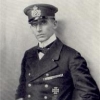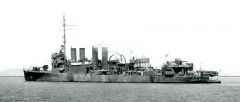A Tempest over Teacups at Balikpapan
It was a very wet day and the sun had yet to put in an appearance even though it was noon. The weather was horrible; a Force 7, 30 knot wind from the NE with squalls galore dotted across the Makassar Strait like too many showers all going at once. If they had been anywhere but at sea there would have been flood warnings.
Rear Admiral Crace (RAN) was in his flagship, HMS Australia steaming north towards Balikpapan to try intercept a purported convoy invading the oil field there. Strung out behind Australia were the cruisers of the ANZAC Squadron reinforced by TF5 of the US Asiatic Fleet. Crace had moved the squadron to Surabaya from Darwin to try and free his ships from convoy duty (He was “tired of nursing those dam tubs along”) so he could strike at the Japanese with his whole squadron. Crace was looking for a fight and a knife fight at that, where his light cruisers could come into their own. Crace didn’t have much faith in the American destroyers of DesRon 29. Their 4” were pop guns and the weather was going to play merry hell with their torpedoes. No, if a fight occurred, it was going to be a cruiser fight.
Australia’s search radar swept the skies and the surface looking for bogies, but nothing since the attack by land based level bombers earlier in the morning. The squadron had escaped without a scratch or even a near miss. Crace asked his Flag Lieutenant what he thought. Flags offered to have the steward serve tea. Crace asked what good tea could do and Flags replied; “It couldn’t hurt.” The squadron steamed on.
Rear Admiral Takagi was taking tea on the bridge of his flagship IJNS Myoko. The Myoko led the 5th Cruiser Squadron, 15th and 16th Destroyer Divisions at 15 knots due east. Takagi had escorted 9 transports to Balikpapan and the troops were ashore now. The 2nd Destroyer Flotilla under the veteran Rear Admiral Tanaka in IJNS Jintsu (flag) was in shore with the 21st Destroyer Division guarding the anchored transports. Takagi was unhappy with the weather, it prevented him from sending float planes from his cruisers or IJNS Chitose to search for the Allied Force the Airedales of the 22nd Naval Air Flotilla had reported bombing earlier in the day. Takagi had no faith at all in the ability of level bombers to destroy warships under way. Takagi felt that he might well rue Vice Admiral Takahashi’s decision to send the Ruyjo to cover the eastern axis invasion of Ambon, as torpedo bombers had a much better chance of damaging enemy ships. Takagi had agreed with the decision when it was made, but a report of an Allied Force of cruisers and destroyers steaming north from Surabaya had been confirmed a few hours later when the 22nd Air bombed them. Now, he could only wait while steaming back forth for the other shoe to drop or the weather to change. But with visibility down to 15,000 yards what could he do. Leaving the anchorage to look for the enemy was tantamount to abandoning Tanaka and the transports if the enemy got past him. Takagi’s force steamed on.
At 1206 hours the wind dropped to Force 5, veered a point to north and the visibility opened uip. HMAS Australia’s masthead reported two Nachi class heavy cruisers dead ahead at 15,000 yards followed by several destroyers appearing from behind a squall. Crace cursed as he realized that random chance had left him with the Japanese crossing his Tee. The Japanese heavies opened on Australia and Canberra, next in line and missed. Australia fired on the leading Japanese cruiser with her fore turrets and hit her twice. Canberra’s fore turrets hit the second cruiser once. USS Houston was blanked by the leading cruisers, but USS Boise, HMAS Perth and HMAS Hobart opened with their fore turrets on the leading Japanese cruiser. They all missed.
At 1212 hours the wind dropped to Force 4 and veered another point to NNW. Crace ordered DesRon 29 to take station to his unengaged (starboard) side and await further instructions. Crace turned his cruiser divisions in succession 8 points to starboard to bring his broadsides to bear. Crace ordered his ships to full speed.
The Japanese cruisers increased their speed and turned away together as their destroyers also increased their speed and laid smoke covering the cruisers.
At 1218 hours only HMAS Australia, HMAS Canberra and USS Houston could bring guns to bear on the leading Japanese destroyer because of the smoke. HMAS Australia hit her twice while Canberra and Houston both missed. The destroyer was seen too stagger under the weight of Australia’s fire and slow dramatically.
At 1224 hours Crace realized that he would have to penetrate the Japanese smoke screen and engage at point blank range to achieve anything more. Crace declined to try that and the engagement ended as both sides broke contact. It would turn out later that the invasion of Balikpapan had already succeeded and the Japanese felt no need to fight at bad odds. For Crace the risk of a close in engagement where torpedoes might very well come to be decisive was not one he was willing to risk. In addition, Australia’s radar showed what had been determined to be the Japanese cruisers retiring, so no renewal of the gunnery fight was likely under conditions that favored Crace’s command. Crace decided to take his hits and return to base.
This was the first surface engagement in another play test of Dave Franklin’s “Defense of the Malay Barrier Campaign” and is written primarily from the ABDA point of view.










